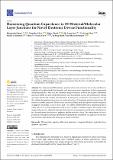| dc.contributor.author | Papnai, Bhartendu | |
| dc.contributor.author | Chen, Ding-Rui | |
| dc.contributor.author | Ghosh, Rapti | |
| dc.contributor.author | Yen, Zhi-Long | |
| dc.contributor.author | Chen, Yu-Xiang | |
| dc.contributor.author | Rehman, Khalil Ur | |
| dc.contributor.author | Chen, Hsin-Yi Tiffany | |
| dc.contributor.author | Hsieh, Ya-Ping | |
| dc.contributor.author | Hofmann, Mario | |
| dc.date.accessioned | 2024-06-13T18:19:17Z | |
| dc.date.available | 2024-06-13T18:19:17Z | |
| dc.date.issued | 2024-06-03 | |
| dc.identifier.issn | 2079-4991 | |
| dc.identifier.uri | https://hdl.handle.net/1721.1/155267 | |
| dc.description.abstract | Two-dimensional (2D) materials promise advances in electronic devices beyond Moore’s scaling law through extended functionality, such as non-monotonic dependence of device parameters on input parameters. However, the robustness and performance of effects like negative differential resistance (NDR) and anti-ambipolar behavior have been limited in scale and robustness by relying on atomic defects and complex heterojunctions. In this paper, we introduce a novel device concept that utilizes the quantum capacitance of junctions between 2D materials and molecular layers. We realized a variable capacitance 2D molecular junction (vc2Dmj) diode through the scalable integration of graphene and single layers of stearic acid. The vc2Dmj exhibits NDR with a substantial peak-to-valley ratio even at room temperature and an active negative resistance region. The origin of this unique behavior was identified through thermoelectric measurements and ab initio calculations to be a hybridization effect between graphene and the molecular layer. The enhancement of device parameters through morphology optimization highlights the potential of our approach toward new functionalities that advance the landscape of future electronics. | en_US |
| dc.publisher | MDPI AG | en_US |
| dc.relation.isversionof | 10.3390/nano14110972 | en_US |
| dc.rights | Creative Commons Attribution | en_US |
| dc.rights.uri | https://creativecommons.org/licenses/by/4.0/ | en_US |
| dc.source | Multidisciplinary Digital Publishing Institute | en_US |
| dc.title | Harnessing Quantum Capacitance in 2D Material/Molecular Layer Junctions for Novel Electronic Device Functionality | en_US |
| dc.type | Article | en_US |
| dc.identifier.citation | Papnai, B.; Chen, D.-R.; Ghosh, R.; Yen, Z.-L.; Chen, Y.-X.; Rehman, K.U.; Chen, H.-Y.T.; Hsieh, Y.-P.; Hofmann, M. Harnessing Quantum Capacitance in 2D Material/Molecular Layer Junctions for Novel Electronic Device Functionality. Nanomaterials 2024, 14, 972. | en_US |
| dc.contributor.department | Massachusetts Institute of Technology. Department of Electrical Engineering and Computer Science | |
| dc.relation.journal | Nanomaterials | en_US |
| dc.identifier.mitlicense | PUBLISHER_CC | |
| dc.eprint.version | Final published version | en_US |
| dc.type.uri | http://purl.org/eprint/type/JournalArticle | en_US |
| eprint.status | http://purl.org/eprint/status/PeerReviewed | en_US |
| dc.date.updated | 2024-06-13T14:54:16Z | |
| dspace.date.submission | 2024-06-13T14:54:16Z | |
| mit.journal.volume | 14 | en_US |
| mit.journal.issue | 11 | en_US |
| mit.license | PUBLISHER_CC | |
| mit.metadata.status | Authority Work and Publication Information Needed | en_US |
